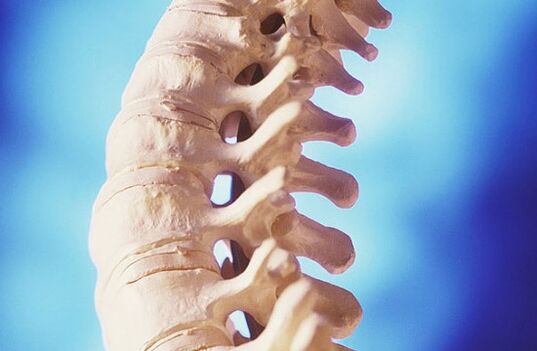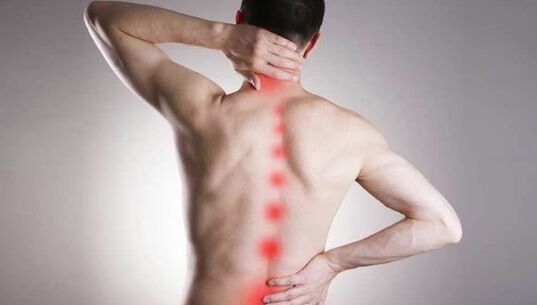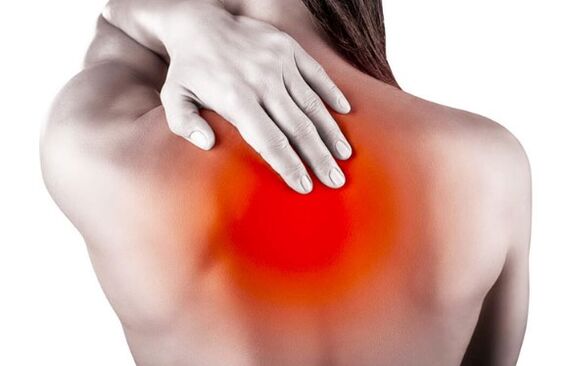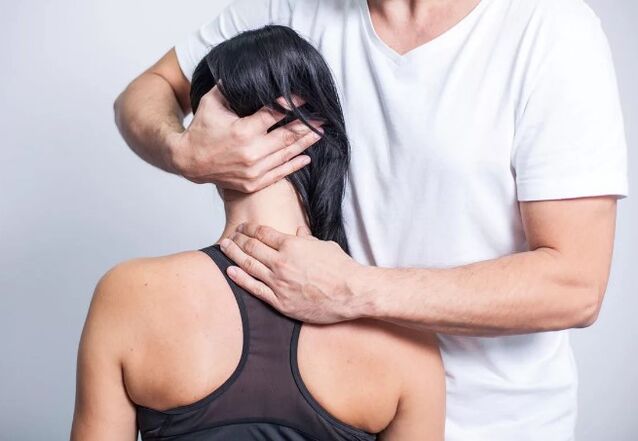Osteochondrosis should be taken seriously. Only the uninitiated think that this is a simple disease that is easy to cope without the help of a specialist. For effective treatment, you should comprehensively approach the problem. Exclude large loads, lead a measured lifestyle, eat right and perform special exercises. In the acute phase, drug support and constant supervision of a doctor will be required.

Osteochondrosis - What is it?
Distrophic processes leading to a partial or complete change in the intervertebral discs. The vertebrae, contracting, crush discs that, under the influence of loads, infections, malnutrition, lose their elasticity. Cleaning, the discs begin to crush on the nerve endings, which causes unbearable pain. The disease at an early stage does not cause serious problems, but the sooner the patient turns to a specialist, the more effective the treatment will be.
At the beginning of the disease, minor changes in the spine occur. Osteochondrosis approaches unnoticed. Small pains appear in different parts of the spine that signaling degenerative-dystrophic processes in discs.
If you do not immediately start treatment, the process can become irreversible and transferred to the tissue of the vertebrae. Distrophy of discs leads to a gradual weakening of external fibrous rings. Patients with osteochondrosis often face complications such as protrusion and vertebral hernia.
Regularly conducted studies in this area provide disappointing statistical data. People over thirty years old often face the spinal disease, 70% of patients suffer from different forms of osteochondrosis. This is a neurological disease that affects the ligaments of intervertebral compounds. It is accompanied by sharp pains, pressure surges and other symptoms that often do not allow people to lead a familiar lifestyle and work normally.
Osteochondrosis does not occur for no reason, sharply, with acute pain. The first symptoms are insignificant and inconspicuous. With an unexpected deterioration in well -being, the appearance of unpleasant sensations in the spine that quickly pass, do not neglect the signals of the body. It is required to immediately consult a doctor for advice and undergo a full examination. Timely started treatment will help to avoid serious complications.
Important. Neglecting the treatment and tips of doctors, you can encounter a protrusion or a parting of a part of the disk - a hernia, in which part of the pulpic nucleus hangs in the cerebrospinal canal and can cause paralysis, infringement of nerve endings expressed in unbearable pain.
There are several types of osteochondrosis, named after localization and the position of pain in the spine.
- Cervical
- Thoracic
- Lumbar.

On examination, the specialist will determine the degree of lesion, the place of exposure and choose the method of complex treatment. The effectiveness of the treatment of osteochondrosis largely depends on the exact observance of all the prescriptions of the attending physician.
Causes
After numerous in -depth studies, experts came to the conclusion that the main reason for the appearance of osteochondrosis is an uneven distribution of loads on different parts of the spinal column. The root cause may be intensive work in unusual conditions, a long sitting in one position, heavy loads during sports training, and blows. The result of an unexpected or prolonged load on a certain area of the spine is a gradual change in the structure of the intervertebral discs.
Among the main causes of the appearance and gradual development of the disease, several basic ones can be distinguished:
- Hereditary changes in the development of the body leading to the appearance of osteochondrosis.
- Diseases of the endocrine system, a failure in the work of metabolic processes.
- The improper development of the skeletal-muscular system leading to pathological changes in the body.
- Any injuries of the back, lower back, neck in falling, training, sharp loads, strikes.
- Inexpensive lifestyle, weighed down by malnutrition.
- Osteochondrosis is an unchanged satellite of overweight people suffering from obesity.
- The abuse of alcohol and nicotine necessarily leads to the destruction of the intervertebral discs.
- Constant psychological and physical exertion, stress and overwork become the root cause of dystrophy of intervertebral cartilage.
- Women at different stages of pregnancy often encounter manifestations of osteochondrosis.

The corset of the spinal muscles supporting the spine is more durable by representatives of the strong half of humanity. Women with magnificent big breasts and playing little sports will necessarily collide with osteochondrosis of the cervical and thoracic region.
The development of osteochondrosis
No disease occurs for no reason and begins immediately. The body always passes changes in step by step. The disease has four main stages that you need to know in order to consult a doctor for help.
- Gradually beginning dystrophic changes in the nuclei of intervertebral cartilage usually occur imperceptibly. Dehydration of the disk becomes the root cause of the occurrence of microcracks, loss of elasticity and thickening of cartilage. Often, people at this stage feel slight discomfort with a long sitting in one pose or with intensive charging.
- The second stage is already difficult not to notice. Degenerative change in tissue leads to the appearance of protrusion. The fibrous capsule is destroyed, and the spinal space is reduced. The result will be pinching of the nerve endings, the appearance of a sharp pain in individual sections of the back. The pain syndrome is actively expressed for any inclinations, sharp turns and running. Osteochondrosis is accompanied by a sharp loss of performance and the appearance of weakness in the body.
- Complete or partial abrasion of intervertebral cartilage laying due to osteochondrosis. The thinning of the tissue is perfectly noticeable during radiography. Symptoms of the disease are pronounced and can lead to partial paralysis. It is impossible to relieve pain, and you have to resort to injections and other drugs on the hearth of the disease. Only potent drugs and complete peace help help.
- This is the last stage, characteristic of the complete destruction of intervertebral cartilage. A complex violation of the neurological system leading to the appearance of bone growths at the site of cartilage. The mobility of the joints is completely disturbed. Osteophytes are able to injure the nerve endings of the vertebrae and bone segments. At this stage for treatment, the help of a surgeon may be needed.

Symptoms of osteochondrosis
Osteochondrosis is a pathological change in the cartilage tissues of the spine connecting discs. Degenerative-dystrophic changes occur for various reasons and lead to the formation of diseases of the ligaments and intervertebral discs. During osteochondrosis, soft tissues and nerve endings are infringed. The vessels and nerve endings, which are near the hearth, experience serious changes, which causes severe pain and violation of the supply of nutrients.
The main symptoms speak of the development of osteochondrosis
It should be attentive to any, even insignificant changes in the body. The faster the preventive measures of influence on the emerging focus of the disease, the more effective the treatment will be.
- There are pains in the neck, chest, lower back and ribs.
- There is a stiffness of movements during turns, inclinations and fast walking, running. When lifting weights, short -term pains appear.
- Hands and legs lose their sensitivity, go numb and swell.
- Chills appear even at high temperatures on the street. Lomota in the lower and upper extremities.
- Unexpected and very painful cramps of the muscles of the legs and arms.
- A pronounced dysfunction in the work of the genitals appears, capable of causing serious psychological injuries.
- The appearance of dizziness and sharp headaches.
- Sharp pain in the chest area, strongly reminiscent of a heart attack state.
- The fingertips are partially or fully or fully sensitive.
- Safe muscle hypotension.
- A sharp decrease in performance, high fatigue, loss of visual acuity.
Symptoms characteristic of the development of the disease in different parts of the spine;
Cervical. Sharp, rapid pain in the shoulders and arms, the appearance of nausea, dizziness and sharp migraine attacks can signal the disease. Inexplicable pressure surges that are not related to the operation of the cardiovascular system.
The appearance of constant noise in the ears, stars before his eyes speaks of the problems of the cervical spine. Older people can suddenly lose consciousness when walking.
Thoracic. The appearance of sharp pains in the front of the chest body, stomach, between the ribs. Breathing becomes more frequent and difficult. Pressure heaviness in the chest area. A sharp pain in the shoulder blades during turns, movement and inclinations. Disorder of the gastrointestinal tract. Attacks of pancreatitis, swelling, diarrhea. The limbs are unexpectedly numb and people can lose balance when walking. Sharp bouts of weakness, a feeling of trembling under the skin appears.
Lumbar. The appearance of dumb increasing pain in the lower back. She can give in a leg, leading to a loss of equilibrium when moving. There are unpleasant tingling in the lower extremities even during rest. When tilted, it becomes difficult to straighten without outside help. Violation in the work of the genitourinary system.
Possible complications

Partial or complete destruction of intervertebral ties leads to the development of numerous chronic diseases. Even a slight pain in the spine, which unexpectedly appeared and also quickly disappeared, should make a person undergo a complete examination. This will help to identify the foci of the origin of the disease and with the help of preventive means to avoid further development of the disease.
Ignoring the first signals, you can face more serious problems:
- The appearance of sharp, prolonged pain in the head, migraine and dizziness.
- Problems in the cervical spine can lead to a sharp loss of vision.
- Often hearing loss is a consequence of a violation of the upper spine.
- The development of osteochondrosis can cause autonomic dysfunction.
- Problems in the lower back lead to a sharp exacerbation of diseases of the genitourinary system.
- Large loads and lack of systemic treatment become the cause of intervertebral hernia.
- People are faced with diseases such as lumbago, spondylarthrosis, lumbalgia.
- Long -term development of osteochondrosis without qualified treatment leads to stenosis of the vertebral channels.
It is necessary to clearly understand that any disorders in the work of the spine will necessarily lead to the development of more complex chronic diseases of the internal organs. Damage to the vascular-fried beams complicates the rhythm of the organs, violates the supply of the required amount of nutrition and the removal of toxins and toxins.
This negatively affects the whole body. Damaged cells and toxins accumulating inside tissues stimulate the development of malignant formations. You can suddenly find out that excellent health has suffered serious damage from slight pain in the lower back, back or neck.
Phase of exacerbation of osteochondrosis
People come across a sharp deterioration in their health in the spring in the lower part of the spine. This may be due to the lack of the required number of minerals and vitamins. Sharp physical loads and temperature changes on the street. In winter, the thoracic region suffers most of all. Due to infectious diseases, hypothermia and irrational nutrition. In the cervical department, a sedentary lifestyle or work in one position sitting most of all. At the first symptoms, you need to use ointments, try to get rid of cramps and edema as quickly as possible. An immediate appeal to a specialist will help to effectively cope with osteochondrosis. When using strong edema, using diuretics, do not forget to take drugs containing potassium and calcium.

Diagnostics
The doctor who is addressed by a patient with sharp pain in the spine should take a sequentially several steps
- Hang -up collection. Conducting a detailed conversation with the patient. The goal is to clarify the root causes of the occurrence of the disease. At what time the most striking attacks arise, which entailed the occurrence of pain. Individual features of the course of the disease "osteochondrosis".
- A thorough personal examination by a specialist. An examination of the skin is carried out for the presence of a rash and edema. The flexibility of the joints and the severity of reflexes is checked. Palpation of a painful area will help localize pain points and find exacerbation. The percussion with fingers or special tools helps to determine the irradiation of pain. By tingling with needles, the degree of sensitivity in different parts of the body is determined.
To obtain the most complete picture of the condition of the body and identify hidden foci, a hardware examination should be applied, which necessarily includes:
- Diagnosis using an X -ray. The picture of the affected area allows you to immediately notice the narrowing of the permissible gap between the spinous vertebrae. The drying of the intervertebral discs is clearly visible in the x -ray.
- MRI, modern technology that guarantees accurate diagnosis of diseases of the spinal department. The use of magnetically resonance tomography helps to determine and localize the place of formation of intervertebral hernia.
- Computed tomography in its significance and effectiveness is not much different from MRI. The only drawback is an increased radiation load, so CT is not recommended to use children.

























